Analysis on Spatio-Temporal Characteristics and Influencing Factors of Industrial Green Innovation Efficiency—From the Perspective of Innovation Value Chain
Abstract
:1. Introduction
2. Literature Review and Hypothesis Development
2.1. Research on the Scientific Measurement of Green Innovation Efficiency
2.2. Study on the Temporal and Spatial Correlation of Green Innovation Efficiency
2.3. Research on the Driving Factors of Green Innovation Efficiency
2.4. Hypothesis Development
3. Research Methods and Index Selection
3.1. Model Selection
3.1.1. Super-Efficient Network SBM Model
3.1.2. Kernel Density Estimation
3.1.3. Spatial Econometric Model
3.2. Index Selection
3.3. Data Collection
4. Result
4.1. Temporal and Spatial Evolution of Industrial Green Innovation Efficiency
4.1.1. Analysis of temporal Series Characteristics of Industrial Green Innovation Efficiency
4.1.2. Analysis of Spatial Characteristics of Industrial Green Innovation Efficiency
4.2. Analysis on Influencing Factors of Industrial Green Innovation Efficiency
Index Selection of Influencing Factors
4.3. Spatial Econometric Model Estimation Results
4.3.1. Technology R&D Stage
4.3.2. Achievement Transformation Stage
5. Discussion
6. Conclusions
Author Contributions
Funding
Institutional Review Board Statement
Informed Consent Statement
Data Availability Statement
Conflicts of Interest
References
- Rowan, N.J.; Galanakis, C.M. Unlocking Challenges and Opportunities Presented by COVID-19 Pandemic for Cross-Cutting Disruption in Agri-Food and Green Deal Innovations: Quo Vadis? Sci. Total Environ. 2020, 748, 141362. [Google Scholar] [CrossRef]
- Chen, Y.; Zhu, M.; Lu, J.; Zhou, Q.; Ma, W. Evaluation of Ecological City and Analysis of Obstacle Factors under the Background of High-Quality Development: Taking Cities in the Yellow River Basin as Examples. Ecol. Indic. 2020, 118, 106771. [Google Scholar] [CrossRef]
- Renjie, Z.; Dong, H. Temporal and Spatial Evolution and Influencing Factors of China’s Industrial Ecological Efficiency Based on Provincial Scale. Econ. Geogr. 2020, 7, 124–132, 173. [Google Scholar] [CrossRef]
- Duan, Y.; Liu, S.; Cheng, H.; Chin, T.; Luo, X. The Moderating Effect of ABSORPTIVE Capacity on Transnational Knowledge Spillover and the Innovation Quality of High-Tech Industries in host Countries: Evidence from the Chinese Manufacturing Industry. Int. J. Prod. Econ. 2021, 233, 108019. [Google Scholar] [CrossRef]
- Cao, X.; Yu, J. Regional Innovation Efficiency in China from the Green Low-Carbon Perspective. China Popul. Resour. Environ. 2015, 25, 10–19. [Google Scholar]
- Fussler, C.; James, P. Driving Eco-Innovation: A Breakthrough Discipline for Innovation and Sustainability; Financial Times/Prentice Hall: Hoboken, NJ, USA, 1996. [Google Scholar]
- Mirata, M.; Emtairah, T. Industrial Symbiosis Networks and the Contribution to Environmental Innovation: The Case of the Landskrona Industrial Symbiosis Programme. J. Clean. Prod. 2005, 13, 993–1002. [Google Scholar] [CrossRef]
- Tariq, A.; Badir, Y.F.; Safdar, U.; Tariq, W.; Badar, K. Linking Firms’ Life Cycle, Capabilities, and Green Innovation. J. Manuf. Technol. Manag. 2019, 31, 284–305. [Google Scholar] [CrossRef]
- Camisón, C.; Monfort-Mir, V.M. Measuring Innovation in Tourism from the Schumpeterian and the Dynamic-Capabilities Perspectives. Tour. Manag. 2012, 33, 776–789. [Google Scholar] [CrossRef]
- Zhang, F.; Ren, S.; Yin, X. High-Tech Industry Green Technology Innovation Efficiency and Its Scale Quality Threshold Effect. Sci. Technol. Prog. Policy 2020, 37, 59–68. [Google Scholar]
- Jia, X.; Lin, S. A Factor Market Distortion Research Based on Enterprise Innovation Efficiency of Economic Kinetic Energy Conversion. Sustain. Energy Technol. Assess. 2021, 44, 101021. [Google Scholar]
- Feng, Z. Research on Industrial Enterprises’ Green Innovation Efficiency in China—Based on Provincial Data by a Dea-Sbm Approach. Forum Sci. Technol. China 2013, 2, 82–88. (In Chinese) [Google Scholar]
- Dong, H.; Li, X.; Zhang, R. Analysis on Temporal and Spatial Characteristics and Driving Factors of Green Innovation Efficiency in Dawan District, Guangdong, Hong Kong and Macao. Econ. Geogr. 2021, 41, 134–144. [Google Scholar]
- Cui, R.; Fei, J.; Sun, Y. Research on the Change of Green Innovation Productivity and Its Spatial Spillover Effect among Provinces in China. Macroeconomics 2019, 6, 132–145. Available online: http://www.cqvip.com/qk/96811b/201906/7002498243.html (accessed on 10 November 2021).
- Gürlek, M.; Koseoglu, M.A. Green Innovation Research in the Field of Hospitality and Tourism: The Construct, Antecedents, Consequences, and Future Outlook. Serv. Ind. J. 2021, 41, 734–766. [Google Scholar] [CrossRef]
- Feng, Z.; Zeng, B.; Ming, Q. Environmental Regulation, Two-Way Foreign Direct Investment, and Green Innovation Efficiency in China’s Manufacturing Industry. Int. J. Environ. Res. Public Health 2018, 15, 2292. [Google Scholar] [CrossRef] [Green Version]
- Mills, E.F.E.A.; Zeng, K.; Fangbiao, L.; Fangyan, L. Modeling Innovation Efficiency, Its Micro-Level Drivers, and Its Impact on Stock Returns. Chaos Solitons Fractals 2021, 152, 111303. [Google Scholar] [CrossRef]
- Silvestre, B.D.S.; Dalcol, P.R.T. Geographical Proximity and Innovation: Evidences from the Campos Basin Oil & Gas Industrial Agglomeration—Brazil. Technovation 2009, 29, 546–561. [Google Scholar]
- Fritsch, M.; Franke, G. Innovation, Regional Knowledge Spillovers and R&D Cooperation. Res. Policy 2004, 33, 245–255. [Google Scholar]
- Jiang, Z.; Lyu, P.; Ye, L.; Zhou, Y.W. Green Innovation Transformation, Economic Sustainability and Energy Consumption during China’s New Normal Stage. J. Clean. Prod. 2020, 273, 123044. [Google Scholar] [CrossRef]
- Huang, Y.; Wang, Y. How Does High-Speed Railway Affect Green Innovation Efficiency? A Perspective of Innovation Factor Mobility. J. Clean. Prod. 2020, 265, 121623. [Google Scholar] [CrossRef]
- Li, J.; Du, Y. Spatial Effect of Environmental Regulation on Green Innovation Efficiency: Evidence from Prefectural-Level Cities in China. J. Clean. Prod. 2021, 286, 125032. [Google Scholar] [CrossRef]
- Zhou, X.; Yu, Y.; Yang, F.; Shi, Q. Spatial-Temporal Heterogeneity of Green Innovation in China. J. Clean. Prod. 2021, 282, 124464. [Google Scholar] [CrossRef]
- Chen, W.; Wang, X.; Peng, N.; Wei, X.; Lin, C. Evaluation of the Green Innovation Efficiency of Chinese Industrial Enterprises: Research Based on the Three-Stage Chain Network SBM Model. Math. Probl. Eng. 2020, 2020, 3143651. [Google Scholar] [CrossRef]
- Xu, S.; Wu, T.; Zhang, Y. The Spatial-Temporal Variation and Convergence of Green Innovation Efficiency in the Yangtze River Economic Belt in China. Environ. Sci. Pollut. Res. 2020, 27, 26868–26881. [Google Scholar] [CrossRef] [PubMed]
- Xiao, R.; Song, Y.; Qian, L. Research on Spatial Spillover Effect of Enterprises’ Green Innovation Output from the Perspective of Value Chain in Two Stages. Financ. Trade Res. 2019, 30, 71–83. [Google Scholar]
- Fei, F.; Lian, H.; Liu, X.; Wang, X. Can Environmental Regulation Promote Urban Green Innovation Efficiency? An Empirical Study Based on Chinese Cities. J. Clean. Prod. 2021, 287, 125060. [Google Scholar]
- Du, K.; Cheng, Y.; Yao, X. Environmental Regulation, Green Technology Innovation, and Industrial Structure Upgrading: The Road to the Green Transformation of Chinese Cities. Energy Econ. 2021, 98, 105247. [Google Scholar] [CrossRef]
- Robinson, S.; Stubberud, H.A. Green Innovation in Germany: A Comparison by Business Size. J. Int. Bus. Res. 2013, 12, 47. [Google Scholar]
- Pan, X.; Guo, S.; Chu, J. P2P Supply Chain Financing, R&D Investment and Companies’ Innovation Efficiency. J. Enterp. Inf. Manag. 2021, 34, 578–597. [Google Scholar]
- Tebaldi, E.; Elmslie, B. Does Institutional Quality Impact Innovation? Evidence from Cross-Country Patent Grant Data. Appl. Econ. 2011, 45, 887–900. [Google Scholar] [CrossRef]
- Gao, Y.; Tsai, S.-B.; Xue, X.; Ren, T.; Du, X.; Chen, Q.; Wang, J. An Empirical Study on Green Innovation Efficiency in the Green Institutional Environment. Sustainability 2018, 10, 724. [Google Scholar] [CrossRef] [Green Version]
- Zhao, L.; Gao, H.; Xiao, Q. An Empirical Study on the Impact of Environmental Regulation on the Efficiency of Green Technology Innovation. Stat. Decis. 2021, 37, 125–129. [Google Scholar]
- Du, J.-L.; Liu, Y.; Diao, W.-X. Assessing Regional Differences in Green Innovation Efficiency of Industrial Enterprises in China. Int. J. Environ. Res. Public Health 2019, 16, 940. [Google Scholar] [CrossRef] [PubMed] [Green Version]
- Ghisetti, C.; Marzucchi, A.; Montresor, S. The Open Eco-Innovation Mode. An Empirical Investigation of Eleven European Countries. Res. Policy 2015, 44, 1080–1093. [Google Scholar] [CrossRef]
- Lin, W.-L.; Cheah, J.-H.; Azali, M.; Ho, J.A.; Yip, N. Does Firm Size Matter? Evidence on the Impact of the Green Innovation Strategy on Corporate Financial Performance in the Automotive Sector. J. Clean. Prod. 2019, 229, 974–988. [Google Scholar] [CrossRef]
- Tone, K.; Tsutsui, M. An Epsilon-Based Measure of Efficiency in Dea–a Third Pole of Technical Efficiency. Eur. J. Oper. Res. 2010, 207, 1554–1563. [Google Scholar] [CrossRef]
- He, Y.; Li, H. Probability Density Forecasting of Wind Power Using Quantile Regression Neural Network and Kernel Density Estimation. Energy Convers. Manag. 2018, 164, 374–384. [Google Scholar] [CrossRef]
- Nasierowski, W.; Arcelus, F. About Efficiency of Innovations: What Can Be Learned from the Innovation Union Scoreboard Index. Procedia—Soc. Behav. Sci. 2012, 58, 792–801. [Google Scholar] [CrossRef] [Green Version]
- Chen, K.; Kou, M.; Fu, X. Evaluation of Multi-Period Regional R&D Efficiency: An Application of Dynamic Dea to China’s Regional R&D Systems. Omega 2018, 74, 103–114. [Google Scholar]
- Eilat, H.; Golany, B.; Shtub, A. Constructing and Evaluating Balanced Portfolios of R&D Projects with Interactions: A DEA Based Methodology. Eur. J. Oper. Res. 2006, 172, 1018–1039. [Google Scholar]
- Liu, Y.; Zhao, G.; Zhao, Y. An analysis of Chinese Provincial Carbon Dioxide Emission Efficiencies Based on Energy Consumption Structure. Energy Policy 2016, 96, 524–533. [Google Scholar] [CrossRef]
- Sabir, R.I.; Sabir, R.M. Managing Technological Innovation: China’s Strategy and Challenges. J. Technol. Manag. China 2010, 5, 213–226. [Google Scholar] [CrossRef]
- Peng, J.; Xu, R.; Fu, L.; Yi, M.; Xu, Y. The Evolution Pattern of Green Innovation Efficiency of Industrial Enterprises in the Yangtze River Economic Belt. China Environ. Sci. 2019, 39, 4886–4900. [Google Scholar]
- Sui, D.Z. Tobler’s First Law of Geography: A Big Idea for a Small World? Ann. Assoc. Am. Geogr. 2004, 94, 269–277. [Google Scholar] [CrossRef]
- Lanoie, P.; Patry, M.; Lajeunesse, R. Environmental Regulation and Productivity: Testing the Porter Hypothesis. J. Prod. Anal. 2008, 30, 121–128. [Google Scholar] [CrossRef]
- Yu, W. Research on Creative Industry Agglomeration and Its Production Efficiency—An Empirical Analysis Based on Provincial Capital and Sub Provincial Cities. Economist 2016, 6, 51–57. [Google Scholar]
- Choi, K.; Narasimhan, R.; Kim, S.W. Opening the Technological Innovation Black Box: The Case of the Electronics Industry in Korea. Eur. J. Oper. Res. 2016, 250, 192–203. [Google Scholar] [CrossRef]
- Hansen, M.T.; Birkinshaw, J. The Innovation Value Chain. Harv. Bus. Rev. 2007, 85, 121. [Google Scholar]
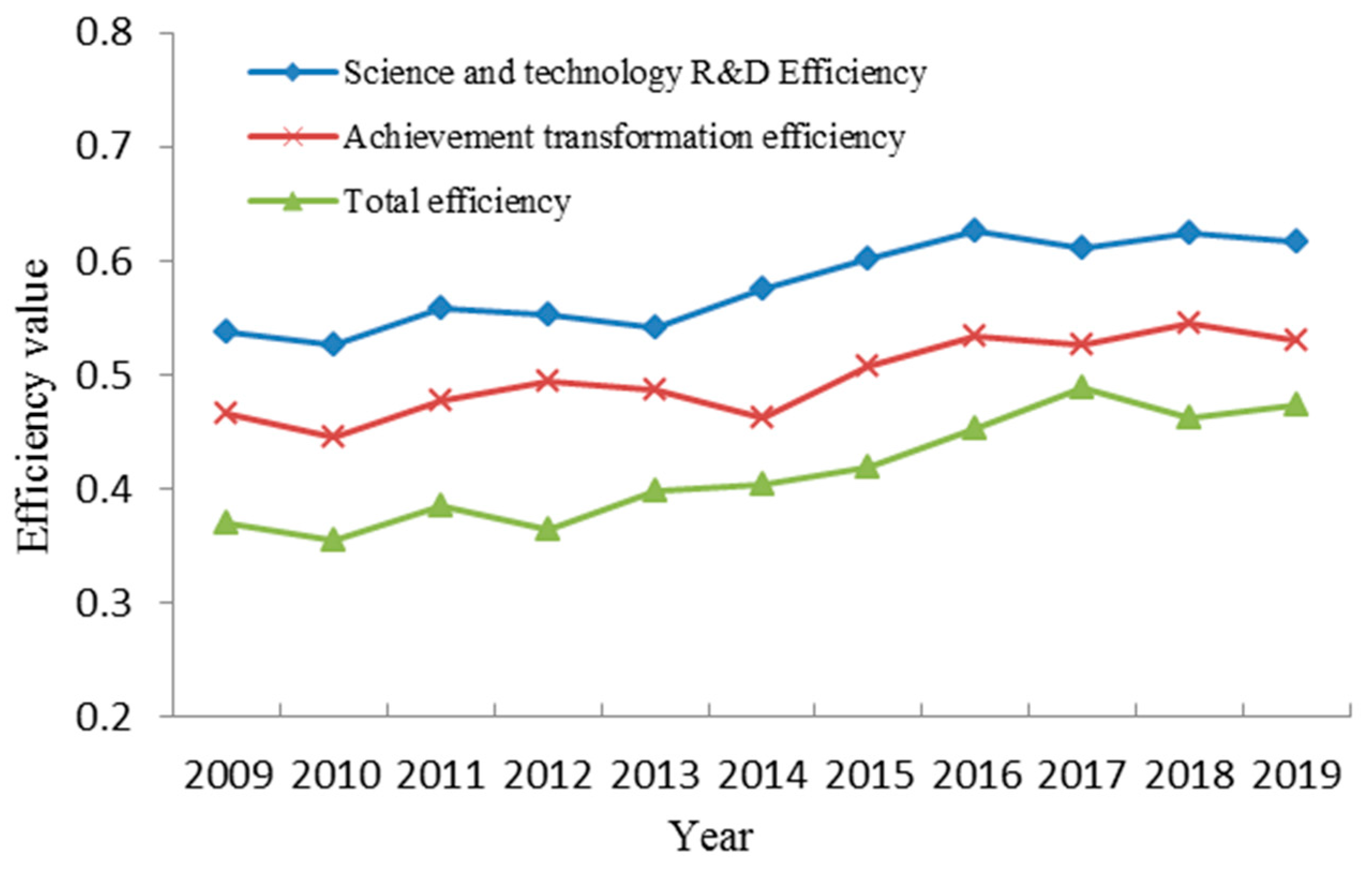
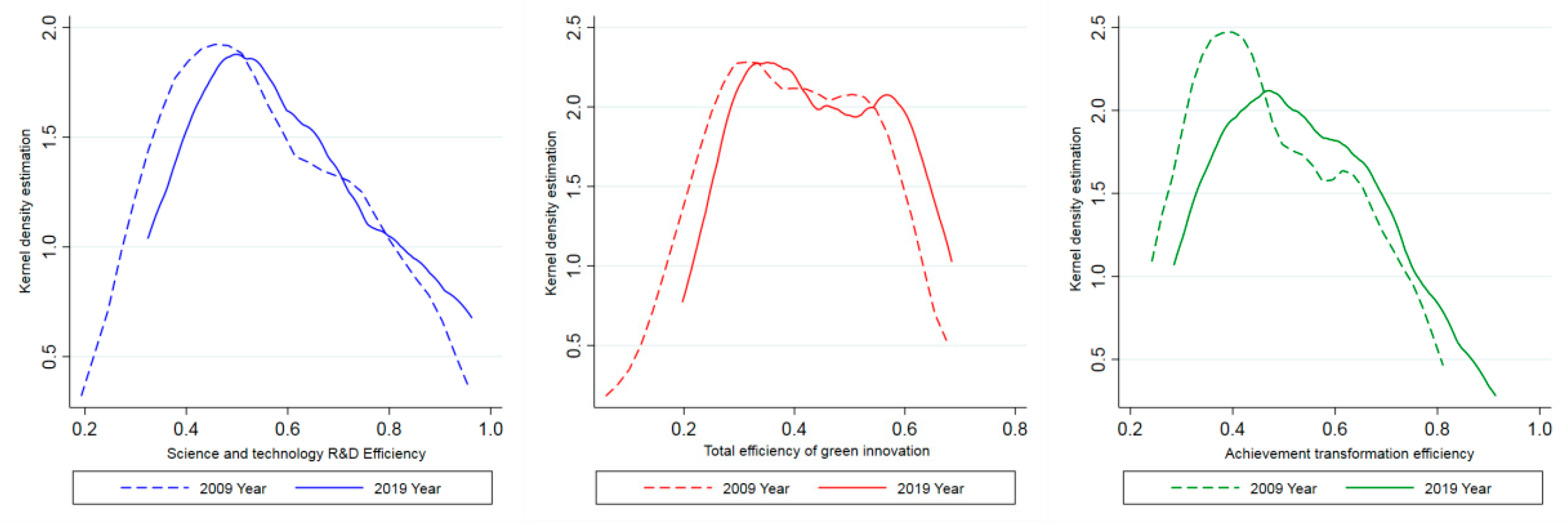
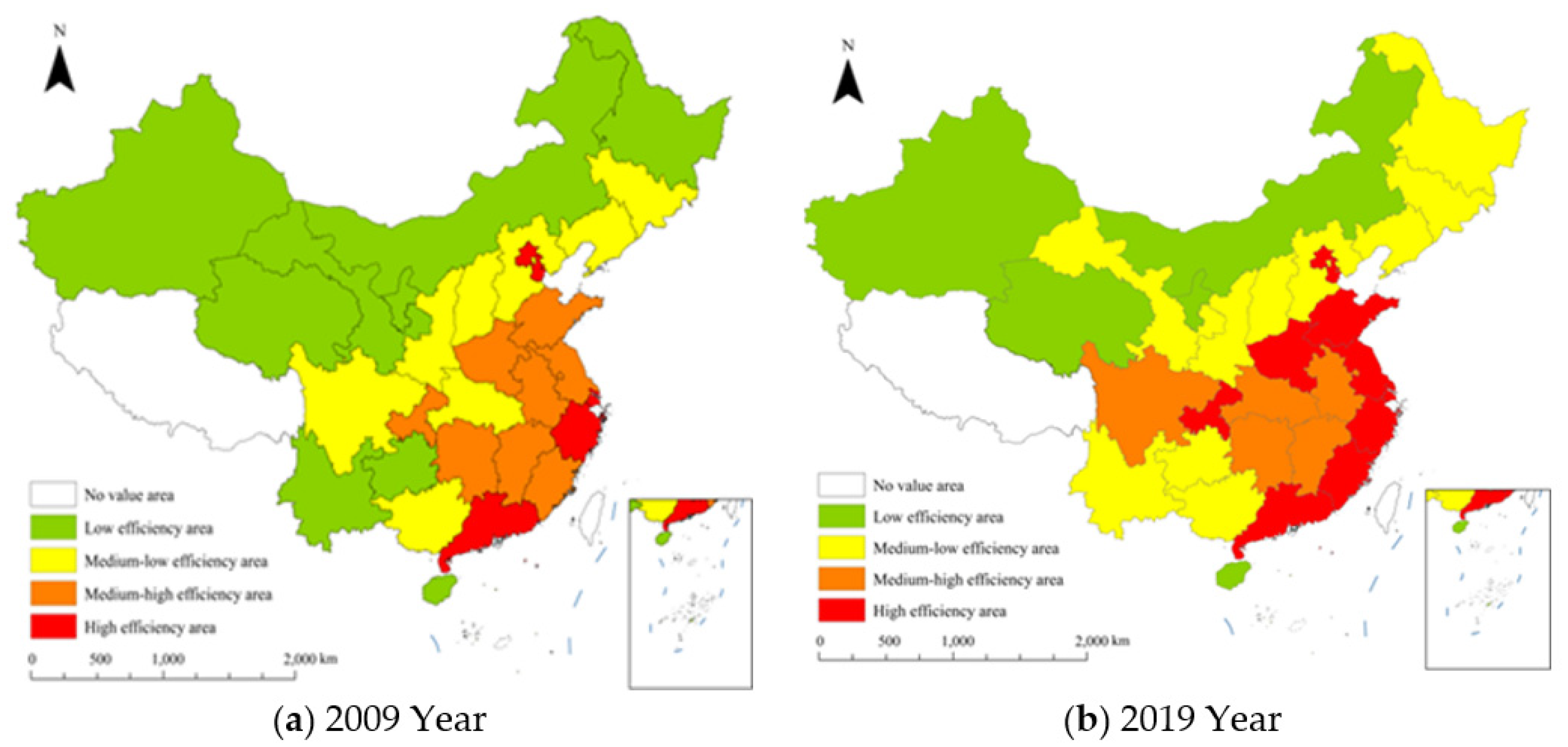
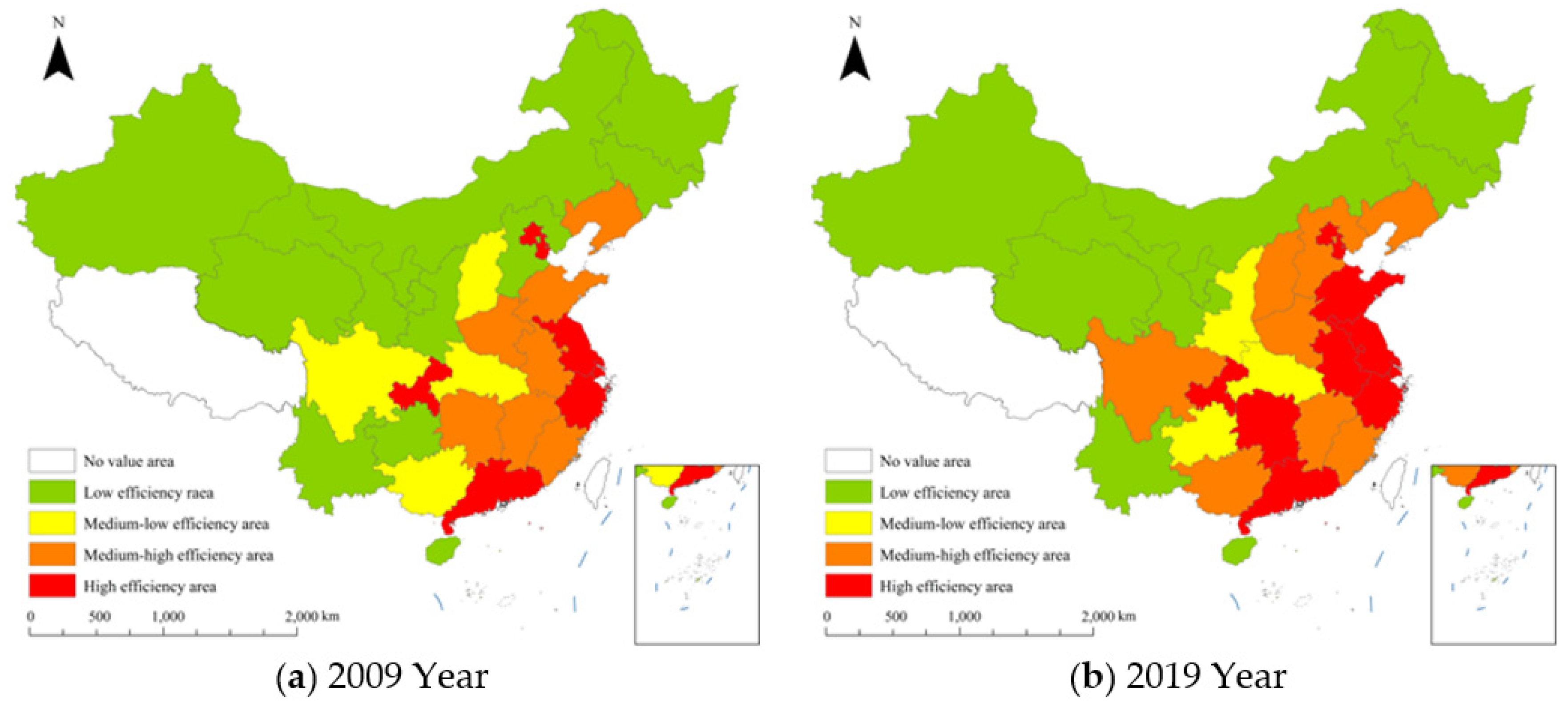
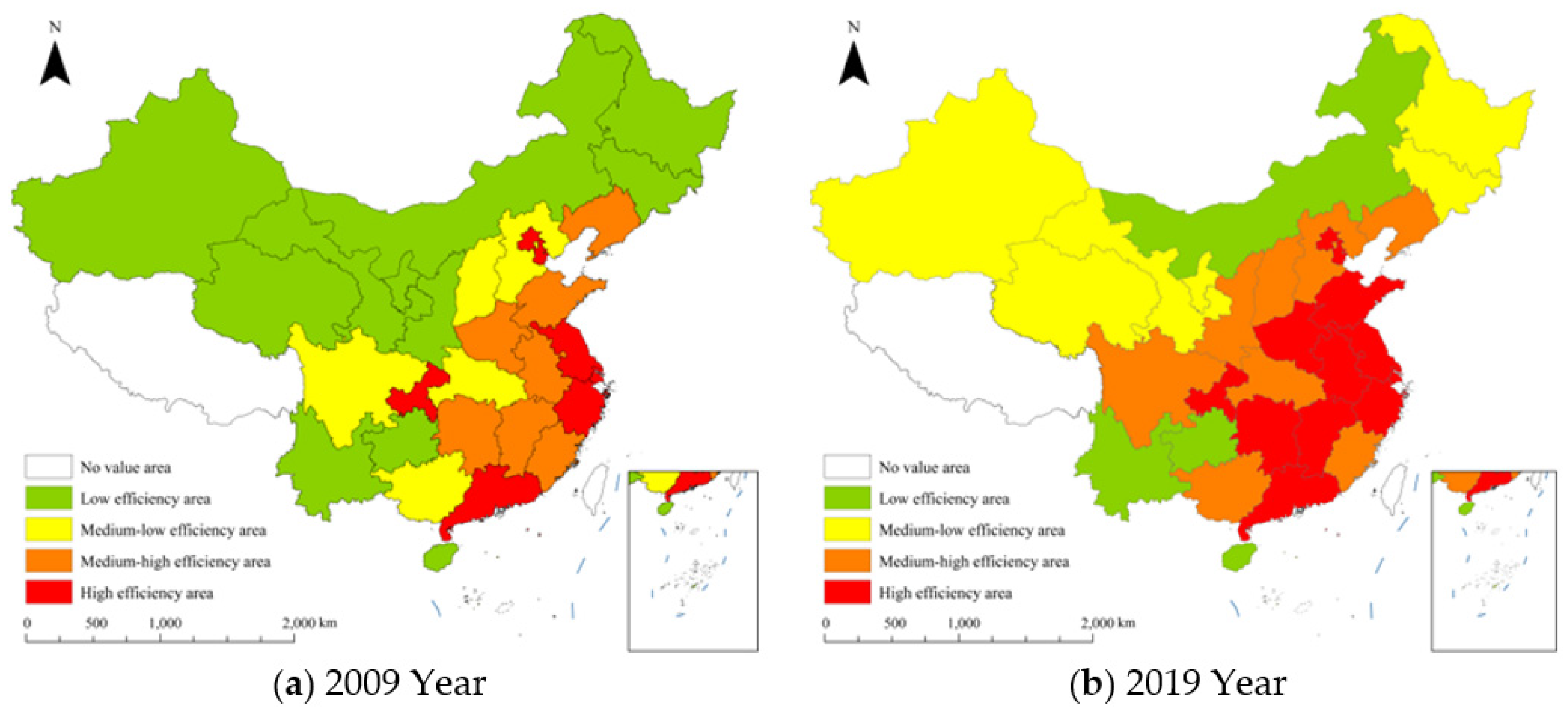
| Indicator Type | Evaluating Indicator | Variable | Unit |
|---|---|---|---|
| Phase I input index | Capital investment | R&D capital stock | 10,000 Chinese yuan (RMB) |
| human input | Full-time equivalent of R&D practitioners | People | |
| Phase II input index | Intermediate outputs | Total patent applications | Piece |
| Authorized amount of invention patents | Piece | ||
| Number of new product development projects | Piece | ||
| Additional investment | New product R&D funds | 10,000 Chinese yuan (RMB) | |
| The cost of purchasing domestic technology | 10,000 Chinese yuan (RMB) | ||
| Total industrial energy consumption | 10,000 tons of standard coal | ||
| Final output | Economic output | Sales Revenue of New Products | Ten thousand Chinese yuan (RMB) |
| Undesirable output | Industrial SO2 emission | 10,000 tons | |
| Industrial wastewater discharge | 10,000 tons | ||
| Discharge of industrial solid waste | 10,000 tons | ||
| Industrial smoke (powder) dust emission | 10,000 tons |
| Variables | Index | Variable Code | Unit |
|---|---|---|---|
| Enterprise scale | Industrial GDP/number of enterprises | ES | 10,000 yuan/piece |
| Degree of opening to the outside world | total imports and exports | OPEN | Ten thousand dollars |
| Industrial structure | Added value of secondary industry/Total GDP | INS | % |
| Government science and technology expenditure | Government science and technology expenditure/Total GDP | GOV | % |
| Environmental regulation | Investment in industrial pollution control | ER | Ten thousand Chinese yuan (RMB) |
| Year | Total Efficiency | Technology R&D Efficiency | Achievement Transformation Efficiency | ||||||
|---|---|---|---|---|---|---|---|---|---|
| Moran’s I | Z Value | p Value | Moran’s I | Z Value | P Value | Moran’s I | Z Value | p Value | |
| 2009 | 0.135 *** | 2.551 | 0.001 | 0.155 *** | 2.954 | 0.003 | 0.088 | 1.125 | 0.156 |
| 2010 | 0.154 ** | 2.083 | 0.014 | 0.176 *** | 2.887 | 0.003 | 0.155 ** | 1.479 | 0.035 |
| 2011 | 0.147 * | 1.654 | 0.055 | 0.194 *** | 2.542 | 0.000 | 0.124 ** | 1.275 | 0.025 |
| 2012 | 0.219 ** | 1.662 | 0.035 | 0.225 *** | 2.114 | 0.000 | 0.097 * | 1.552 | 0.075 |
| 2013 | 0.176 * | 1.445 | 0.075 | 0.216 ** | 1.844 | 0.017 | 0.105 ** | 1.758 | 0.034 |
| 2014 | 0.251 *** | 2.668 | 0.001 | 0.207 ** | 2.439 | 0.011 | 0.133 | 1.874 | 0.185 |
| 2015 | 0.168 *** | 2.105 | 0.001 | 0.258 *** | 2.977 | 0.000 | 0.154 ** | 2.033 | 0.044 |
| 2016 | 0.227 ** | 1.857 | 0.025 | 0.244 *** | 3.012 | 0.001 | 0.127 | 1.776 | 0.274 |
| 2017 | 0.215 *** | 2.761 | 0.000 | 0.269 *** | 3.174 | 0.000 | 0.144 * | 1.836 | 0.077 |
| 2018 | 0.226 *** | 1.795 | 0.000 | 0.231 *** | 2.785 | 0.000 | 0.166 ** | 2.105 | 0.021 |
| 2019 | 0.238 *** | 2.223 | 0.001 | 0.285 *** | 2.655 | 0.000 | 0.183 ** | 2.154 | 0.030 |
| Variables | Science and Technology R&D Efficiency | Achievement Transformation Efficiency | ||||||
|---|---|---|---|---|---|---|---|---|
| OLS | SAR | SEM | SDM | OLS | SAR | SEM | SDM | |
| lnES | −0.035 * | −0.131 | −0.041 | −0.128 | 0.277 * | 0.182 ** | 0.107 ** | 0.151 ** |
| lnOPEN | 0.396 ** | 0.277 *** | 0.286 ** | 0.322 *** | 0.303 *** | 0.411 *** | 0.274 *** | 0.318 *** |
| lnINS | 0.057 *** | 0.077 ** | 0.106 *** | 0.063 *** | 0.154 | 0.135 | 0.118 | 0.217 |
| lnGOV | 0.085 *** | 0.121 *** | 0.097 *** | 0.141 *** | 0.124 * | 0.088 | 0.115 | 0.136 |
| lnER | 0.158 *** | 0.141 *** | 0.131 *** | 0.144 *** | −0.065 ** | −0.117 *** | −0.104 *** | −0.114 *** |
| lnES × W | 0.215 | −2.04 ** | ||||||
| lnOPEN × W | 0.211** | 0.234 *** | ||||||
| lnINS × W | 0.041*** | 0.146 | ||||||
| lnGOV × W | 0.124 | 0.159 | ||||||
| lnER × W | 0.087** | 0.102 | ||||||
| λ/ρ | 0.135 *** | 0.207 *** | 0.241 *** | 0.037 * | 0.145 *** | 0.187 *** | ||
| R2-ad | 0.701 | 0.677 | 0.715 | 0.737 | 0.651 | 0.635 | 0.688 | 0.704 |
| Log-likelihood | 215.225 | 227.326 | 248.542 | 210.235 | 214.568 | 227.305 | ||
| Individual effect | Fixed | Fixed | Fixed | Fixed | Fixed | Fixed | Fixed | Fixed |
| Time effect | Fixed | Fixed | Fixed | Fixed | Fixed | Fixed | Fixed | Fixed |
| N | 330 | 330 | 330 | 330 | 330 | 330 | 330 | 330 |
Publisher’s Note: MDPI stays neutral with regard to jurisdictional claims in published maps and institutional affiliations. |
© 2021 by the authors. Licensee MDPI, Basel, Switzerland. This article is an open access article distributed under the terms and conditions of the Creative Commons Attribution (CC BY) license (https://creativecommons.org/licenses/by/4.0/).
Share and Cite
Liu, P.; Zhang, L.; Tarbert, H.; Yan, Z. Analysis on Spatio-Temporal Characteristics and Influencing Factors of Industrial Green Innovation Efficiency—From the Perspective of Innovation Value Chain. Sustainability 2022, 14, 342. https://doi.org/10.3390/su14010342
Liu P, Zhang L, Tarbert H, Yan Z. Analysis on Spatio-Temporal Characteristics and Influencing Factors of Industrial Green Innovation Efficiency—From the Perspective of Innovation Value Chain. Sustainability. 2022; 14(1):342. https://doi.org/10.3390/su14010342
Chicago/Turabian StyleLiu, Pengzhen, Liyuan Zhang, Heather Tarbert, and Ziyu Yan. 2022. "Analysis on Spatio-Temporal Characteristics and Influencing Factors of Industrial Green Innovation Efficiency—From the Perspective of Innovation Value Chain" Sustainability 14, no. 1: 342. https://doi.org/10.3390/su14010342
APA StyleLiu, P., Zhang, L., Tarbert, H., & Yan, Z. (2022). Analysis on Spatio-Temporal Characteristics and Influencing Factors of Industrial Green Innovation Efficiency—From the Perspective of Innovation Value Chain. Sustainability, 14(1), 342. https://doi.org/10.3390/su14010342






